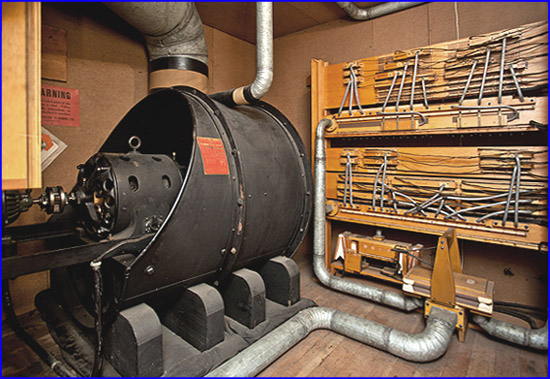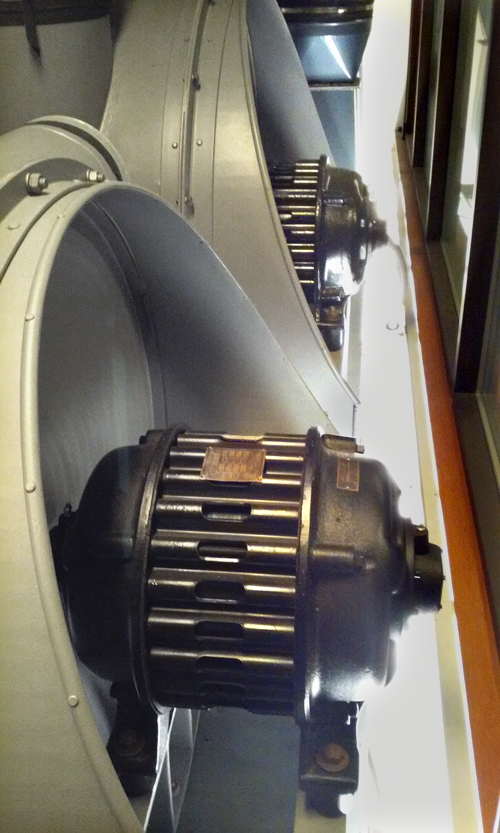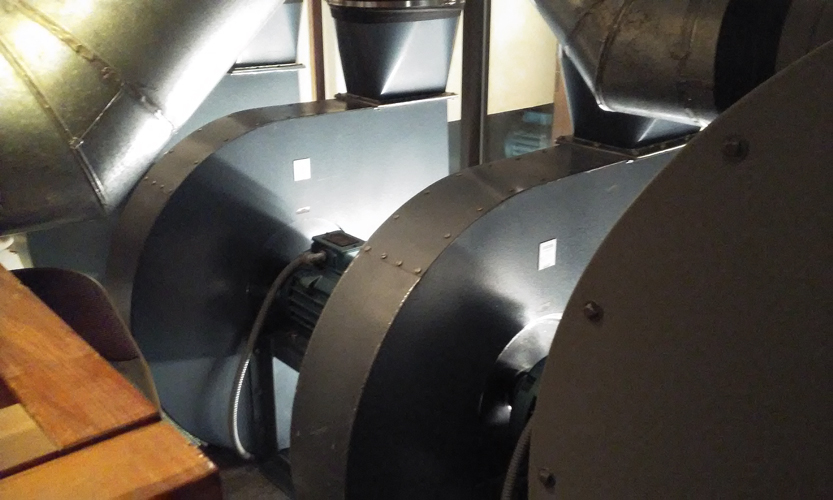The PIPE ORGAN
North Suburban HAMMOND ORGAN Service
Specific sub-systems - The Winding System
The first subsystem of a pipe organ that we'll look at is the winding system, which is responsible for supplying the pressurized air to the pipes, and also for the action if it is electropneumatic.
Although initially large bellows were used since antiquity to supply the air to most pipe organs, around the 1900s bellows were replaced by centrifugal blowers. See figure four on this page. The pressurized air in a pipe organ is referred to as wind in the lingo of the pipe organ, so I will adhere to that practice here. Regarding the air pressure; as compared to most industrial uses of compressed air, the pressure in all pipe organs is quite low, around 3.5 PSI is the higest pressure you would ever encounter, and usually the pressure is not even one pound per square inch. However, what the pipe organ lacks in pressure, it makes up in volume. Air supplies for large pipe organs can deliver thousands of cubic feet per minute. For this reason, the centrifugal blower is the machine of choice when it comes to supplying air to a pipe organ.

Figure 6. A typical 3 stage Spencer blower powering a pipe organ. Some idea of the power required may be gleaned from the size of the motor which has a lifting eyebolt, although these older style motors are larger and heavier per HP than newer motors. This machine has an extra third stage as evidenced by the smaller discharge pipe leaving the blower just above and to the right of the red label. The larger discharge pipe leaving behind and on top is the main air supply to the organ. The high pressure takeoff supplies air power to among other things an electropneumatic combination action in the console. It may also supply one or two ranks of pipes on extra high pressure. Notice also that at the front end of the motor on this blower there is a coupling. This is for driving the DC generator that supplies the necessary DC to operate the electropneumatic action of the instrument.
Figure 7. 3 phase induction motors driving two 2-stage blowers for large concert/orchestral organ.

Pressure measurements are relative, however, and there are instruments which use low pressure air, and instruments which use medium pressure and those that use high pressure. Because we are dealing with pressures that are actually quite low, the usual measurement for wind pressure in organs is not the familiar pounds per square inch or PSI, but rather inches of water. If you are unfamiliar with this system of pressure measurement, it simply means, how high a column of water will a given air pressure support?
As a means of comparison, a column of water that is 27.67 inches high will represent a pressure of one pound per square inch. That is, if we take a U shaped glass tube that has its straight vertical legs say thirty inches long, and fill it about half full of water, and leave both ends of the tube open, the water will balance out and be about fifteen inches deep in each side of the U tube. If we hook up a supply of air at a pressure of one PSI to one side of this U tube and leave the other end open, the air will push the water down in the side that's hooked up to the air supply. At the same time, the water will rise in the other leg of the U. When the difference in the heights of the water in the two sides of the tube is 27.67 inches, the water will then remain at this new balance. This means that the air pressure is balancing or supporting a water column of 27.67 inches in total height. Diameter of the tube makes no difference, the water's height differential will remain at 27.67 inches whether both sides of the tube have the same diameter or different diameters or even different cross-sectional shapes. The only measurement here that means anything at all is the water height differential between the two sides of the tube; the side hooked up to the compressed air, and the other side that's open to atmosphere.
Pressures in pipe organs range from a low of 2 inches of water to 100 inches of water. Knowing now that it takes 27.67 inches of water to equal one PSI, we know that 100" pressure is really only about 3.5 PSI. But all of this is relative. In pipe organ work, low pressure is usually 2 to 4 inches, medium pressure is 5 to 8 inches, high pressure is usually 10" and higher, and very high pressure is usually 15" and up. But you can generate lots of sound even with low pressure air, and even these low pressures can also accomplish mechanical work. In terms of generating sound, it is a function of both the pressure AND the volume of air that is modulated into sound waves. In reference to mechanical work, the FAP rule is the important consideration. FAP is the accronym for the formula Force = Area × Pressure. So if you have a high pressure over a small area, or a lower pressure over a bigger area, you can still develop the same force.

Figure 8. Two of three single stage centrifugal blowers for a large concert/orchestral pipe organ.
Because the "power" represented by compressed air involves both the pressure and the flow, even though pipe organs use air at low pressures, when compared to other things that also use compressed air, in the case of a large instrument, significant horsepower is required to supply the air. The most typical blower that we find on the majority of electropneumatic pipe organs is the Spencer turbine blower; and the typical machine is usually a two-stage unit, with its impellers running at the standard speeds for induction motors on 60 Hz power which are nominally 3600, 1800 and 1200 RPM, with a few large units running at 900 RPM. Those of you who are familiar with AC motors will recognize these as the synchronous speeds for motors of two, four, six, and eight poles respectively. Typical HP for most pipe organ blowers is in the range of 3 to 25HP, with really large instruments requiring blowers up to 100 HP, likewise for very small low pressure portable and residence pipe organs, blowers need not be any more than 0.25 HP.
Previous Page Page 7.
Next page